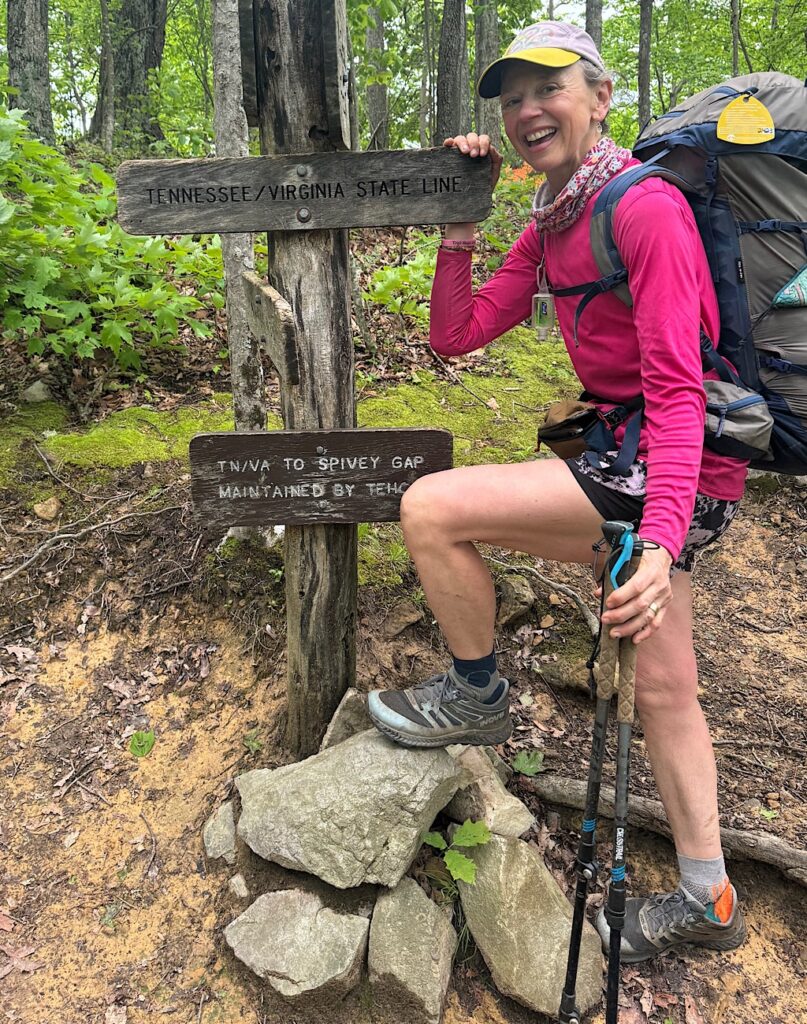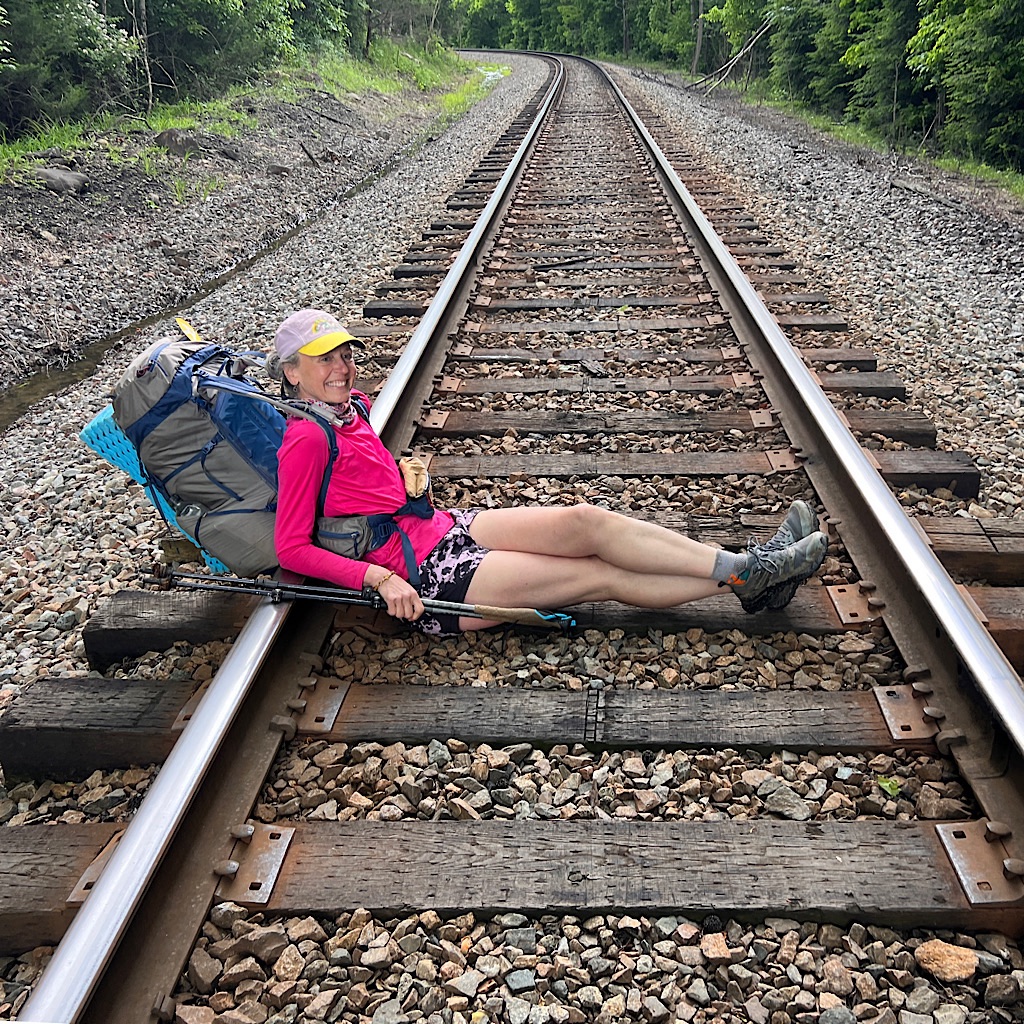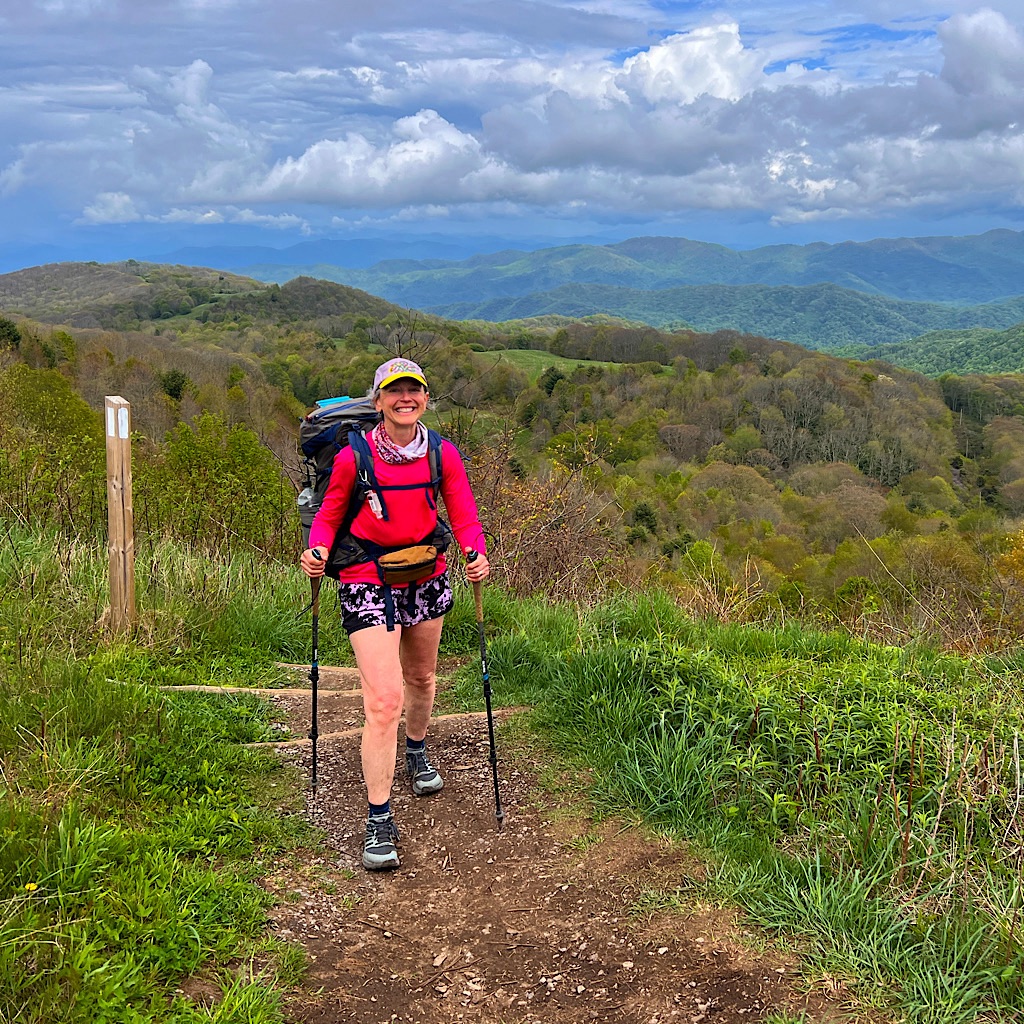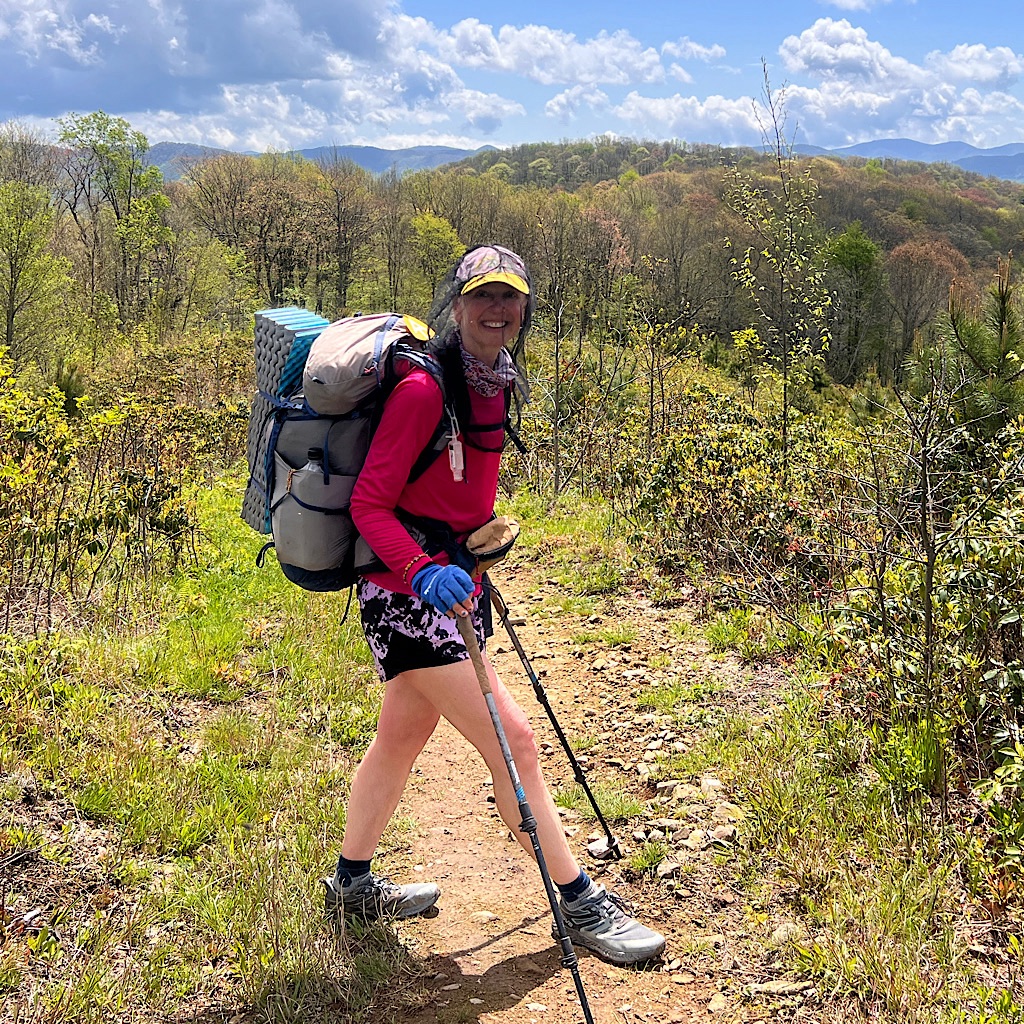…or how a nearly 60-year-old woman with fake hips walked 480 miles in less than a month

When I posted a photo of myself being interviewed by WCYB News on the Appalachian Trail, a friend wondered what on earth had happened to my knee.
The angle of the picture was all wrong and made my knee appear hyper-extended. But my knees in reality are a bit deformed and perpetually swollen from arthritis. It could also be that my friend saw my picture through the lens of her own recent knee replacement.
Truth is, my knees may be ugly, but they’re the strongest they’ve ever been. Not because I’m particularly fit or have beaten arthritis, but because I’ve made some small changes that are keeping me upright and walking even after having both hips replaced with titanium.
Changing the Mindset
Most of you tend to see me as a can-do person, a type-A personality who dives into projects with enthusiasm and optimism, seeing them through to completion.
Truth is I’m a bit of a closeted pessimist. Worry and panic tend to spiral out of control if I don’t hold them in check. That might be why one of my neighbors in Houston years ago dubbed me “Chicken Little,” making me giggle every time she yelled it out as I passed by.
Four years ago I thought I’d pulled a groin muscle and soon could barely walk. That’s when I learned all of the cartilage in my hips was worn away completely. The only solution was to have them replaced. The good news is I am fully healed, have superb range of motion, never feel pain and the devices are supposed to last 30 years…if I give up jumping and running.
Easy enough.

Though over time, as arthritis took hold swelling up my fingers and toes, I feared that the knees were next. And a baseline X-ray confirmed those fears. I figured I was doomed for a life as at least partially bionic.
But a funny thing happened on the way to the orthopedic surgeon. They do get a bad wrap for wanting to cut us open no matter the level of damage, but my doc told me that some people who have a lot of serious wear find their body can adjust to it and they can keep moving for years without medical intervention.
She then went on to say, “I believe you can do whatever you set your mind to.”
Call it woo-woo nonsense, but she planted a seed. I soon became determined to put off a dreaded knee replacement as long as humanly possible. Changing my mindset was just the start and led me to something that I really could control: my lifestyle.
Changing the Diet
It all happened on a hike I led at Afton State Park two winters ago. It was a beautiful day, not too cold with sparkling snow and ice under a bluebird sky. I brought treats for the group in the form of mini candy bars, the kind you hand out on Halloween. Not one of the dozen women hiking accepted this sugary treat.
At first they said nothing. But then one piped up and soon the others joined in a chorus: “Sugar is terrible for you.” they said and I heard it as if for the first time.
They’re right. Sugar is just empty calories with no nutritional value whatsoever. Sugar causes inflammation in the body and is the number one culprit – outside of age – of worsening arthritis. As are refined carbohydrates, highly processed foods, sodas and alcohol.
I never considered myself a junk-food junkie, though that is the food of choice of a thru-hiker. And I was most certainly drinking a lot at that point in my life. So, with two days left to the year, I made my resolution to give up sugar and booze cold turkey.

I can’t say that I never eat sugar or sip a dram of 12-year Scotch (just ask my pal Mark in Arizona!) but I have noticed a remarkable change in my body since abstaining. It’s not so much about my weighing less as feeling lighter, far more flexible and most wonderful of all, stronger.
Six months later I would read the World Health Organization blockbuster report connecting the consumption of alcohol and an elevated risk for breast cancer. Perhaps it was too late for my cancer diagnosis, though I credit my ability to manage treatments to my improved overall health.
Changing the Exercise
Just like every stool needs three legs to stand, we also need three strategies when looking for ways to extend the longevity of our legs, and specifically, our knees. That would be by proper and targeted exercise.
I’ve been doing a warm-up workout each morning that includes squats and calf stretches, a two-minute plank plus poses on a bosu ball to increase proprioception, the way my body balances while in motion.
Recently, I was sent a book to review that has opened up a whole new perspective in knee health. The book is called 6-Minute Knee Pain Cure by a former Army Physical Therapist, Dr. Jonathan Su.
Dr. Su encountered his own knee injury when he was only 15. It was so catastrophic and the prognosis was grim, He feared that he would never be active again. Unwilling to accept his fate, he made it his life goal to learn how to rehabilitate himself completely without overusing drugs or having to resort to surgery.
Dr. Su was successful and shares his wisdom plus the techniques he used on himself and thousands of patients. It’s an alternative to traditional medicine that includes an array of exercises that are simple and take very little time and equipment to execute.

Su’s premise for reducing knee pain is three-fold: to restore alignment, rebalance strength and release excess tension. He explains in detail, aided by pictures and videos, what to do and what not to do in a series of exercises that should be extremely familiar to you.
But it’s in how he sets up the program that makes this book so valuable. He has us choose our own plan based on which will offer small improvements, then sticking to only those exercises for a week at a time. As well, he focuses on limiting the time spent doing the exercise so it can be done properly with total focus.
This is my current routine:
- Restore Alignment: “Side-Lying Bent Leg Lift” which engages the hip rotator muscles and helps with side-to-side alignment, eventually incresing the ability of the knee to hold the body’s weight efficiently.
- Rebalance Strength: “Heel Lift” which targets the calf muscles because my calf muscles are always tight and complaining.
- Release Excess Tension: “Hamstring Tension Release” which comes in three parts – roll, shake and stretch.
In the end, he answers just about every question you might have, like the one burning in me: “Can this program provide benefits even if X-rays or MRI show that my knee is bone-on-bone or I severe osteoarthritis?”
The answer is yes, although he does ask each reader to do a small knee-bend-and-lift test at the outset to assure these exercises can help. (I passed)
I am well into seeing results from these exercises and I highly recommend his book.
The Secret to a Healthy Life? Keep Walking
On my one-month Appalachian Trail Trial, I surprised myself by walking strong, (mostly) pain-free and all of the miles I wanted to. I credit the three things I listed for allowing me to keep moving so well as I approach 60: mindset, diet and targeted exercise.
Age is way more than a number and I’m no longer fast on downhills and my legs aren’t as shapely as they were when I was young (see first graph) but they’re still taking me where I want to go.
And for that, I’ll put up with a little cellulite and saggy butt!

I keep my backpack weight and my own weigh down to extend the longevity of my titanium hips as well as the rest of my the legs I came into this world with.


4 Responses
Hi Alison,
Would love to know more about how you tackled your foot pain (arthritis). I have a long history of walking and outdoor pursuits, 13 expeditions to the Himalayas. In the last two years or so I noticed a deviation in my big toe (right foot) Hallux Limitus, this seemed to happen very quickly and coincided with a period in which I was doing a lot of running.
I am 65 years old, not carrying any weight, a semi-regular yoga practitioner and an all-round gym junkie.
This condition is painful and seems to be getting worse. I am seeing a Podiatrist for further investigation but would appreciate your views.
Please keep the inspirational walks coming.
Thanks
John
Thanks so much for your note, John. I am impressed (and very envious) of your many expeditions to the Himalayas.
And also sorry that you are managing foot issues.
I was diagnosed with hallux limitus in my early 30’s. I immediately retired my high heels and replaced them with wide toe-boxed shoes (Dansko clogs and trail runners) I wear a Superfeet orthotic and use gel spacers between the big and second toes.
In addition, I added toe stretches to my daily routine as well as ball rolling, calf raises and a weird little exercise where I pick up small items using my big toe and second toe like fingers. All of these exercises also help with managing plantar fasciitis which has creeped into my life!
The good news for me was that my condition never turned into hallux rigidus, which is far more serious and limiting condition. I rarely have pain in the toes anymore, just a huge, ugly, deformed and bony bump.
I should add that I no longer run. This is primarily to protect my titanium hips, but also to save my toes for as long as possible. I saw a foot podiatrist who wanted to do surgery on my big toe. I did not go that route.
I hope this helps! Do keep in touch.
Hi, Allison.
Thanks for sharing your sagas.
Did you see hikers with hammocks getting drier or better sleep.?
We have natural conversions to Keytones.
If you search to “Fasting for Survival”, one of several free lectures at Fla. State Univ. Medical School by Cardiologist, Assistant Professor, Doctor Jamnadas.
It is how our liver can reverse and pull fatty acids out of storage & convert them to Keytones, greater energy.
Thanks again for sharing…
Larry Tippens
Learning/ practicing hiking…
Restorative Yoga Instructor
Retired Army
Thanks for your comment, Larry. People seem to like hammocks but they are heavier to carry, require good trees and you can’t sit up in a hammock so I prefer a tent.